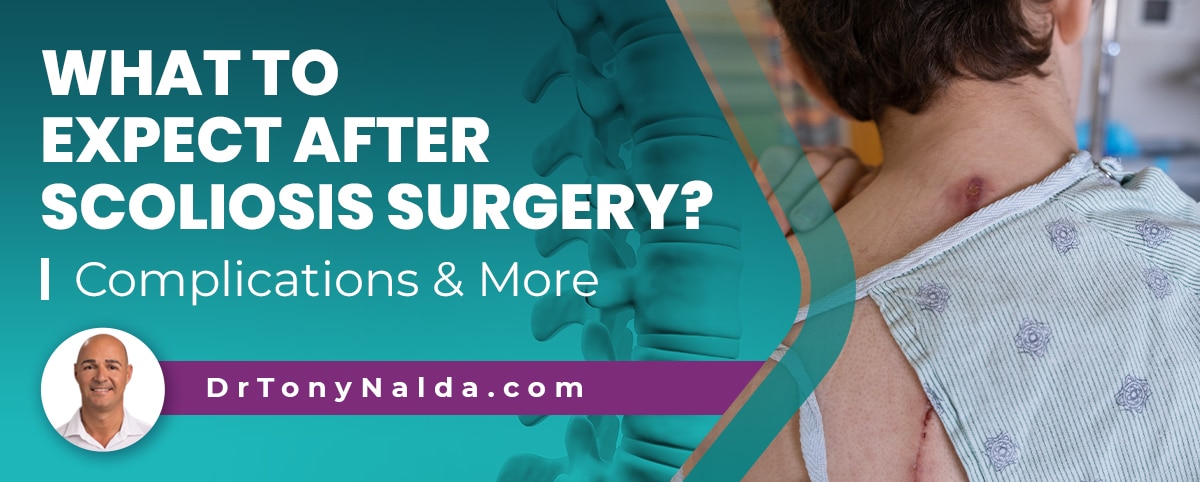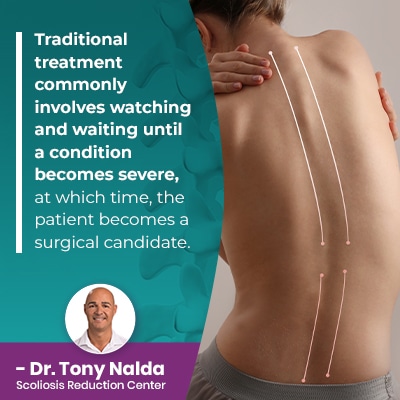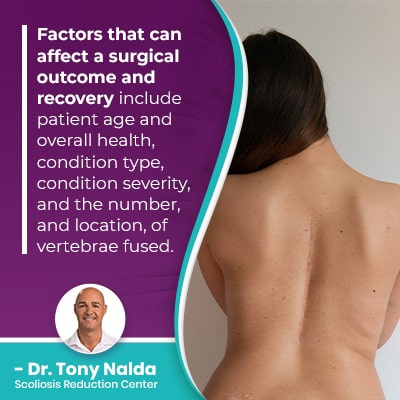What To Expect After Scoliosis Surgery? Complications & More

There is more than one scoliosis treatment approach, and it's important to understand that different types of treatment offer patients different potential outcomes; the way a condition is treated establishes future spinal health and function, so quality of life can be affected.
While all surgeries come with risks, spinal fusion surgery does carry some serious potential risks, side effects, and complications. Every patient will respond to scoliosis surgery in their own way, but in general, pain management, rest, and activity restrictions/modifications can be expected.
Before getting to the specific risks and complications associated with spine surgery, let's first define the condition, and discuss the two main scoliosis treatment approaches.
Table of Contents
What is Scoliosis?
Scoliosis is a progressive spinal condition that involves the development of an unnatural sideways spinal curve; a characteristic that sets scoliosis apart from a number of other spinal conditions that involve a loss of its healthy curves is its rotational component, making scoliosis a 3-dimensional condition.
As a progressive condition, the nature of scoliosis is to get worse over time, and that means the size of the unnatural spinal curve is going to increase, and as this happens, the condition is introducing more and more uneven forces to the spine, its surrounding muscles and nerves, and the entire body.
The main way scoliosis affects the body in children is postural deviation, and this is caused by the condition's uneven forces disrupting the body's overall symmetry, and the main symptom of scoliosis in adults is pain; this is because scoliosis becomes a compressive condition once skeletal maturity has been reached.
In addition, progression makes the spine increasingly rigid, which makes it less responsive to treatment and can make it challenging for some patients to even perform certain therapeutic exercises as a facet of treatment.
Basically, as a progressive condition, where a scoliosis is at the time of diagnosis is not always indicative of where it will stay, and scoliosis ranges from mild to moderate and severe to very severe.
A patient's Cobb angle measurement, obtained via X-ray, is determined by drawing lines from the tops and bottoms of the curve's most-tilted vertebrae, at its apex, and the resulting angle is expressed in degrees; condition severity is determined based on Cobb angle:
- Mild scoliosis: Cobb angle measurement of between 10 and 25 degrees
- Moderate scoliosis: Cobb angle measurement of between 25 and 40 degrees
- Severe scoliosis: Cobb angle measurement of 40+ degrees
- Very-severe scoliosis: Cobb angle measurement of 80+ degrees
The goal of proactive scoliosis treatment is to prevent progression and increasing condition-effects by working towards corrective results; the goal of reactive scoliosis treatment is to stop progression by only responding with treatment once a condition has progressed to moderate and/or severe.
Now that we've defined the condition and explored its progressive nature, let's move on to the differences between the two main scoliosis treatment approaches: one funnels patients towards surgery, and one strives to prevent it.
Scoliosis Treatment Approach
The two main scoliosis treatment approaches are known as traditional and conservative, and as each has a different end goal and approach, it affects the spine differently.
I want my patients to be aware of all treatment options available to them because there was a time when a surgical response was commonly the only treatment option presented, and the reality is that many cases of scoliosis don't require surgery.
Scoliosis is a condition that's been around since ancient times, so we have come a long way in our understanding of the condition and how it responds to different types of treatment.
Traditional Scoliosis Treatment and Scoliosis Surgery
Traditional scoliosis treatment was the dominant treatment choice for many years, but that doesn't mean it's the best, nor the only treatment option available.
 Traditional treatment commonly involves watching and waiting until a condition becomes severe, at which time, the patient becomes a surgical candidate.
Traditional treatment commonly involves watching and waiting until a condition becomes severe, at which time, the patient becomes a surgical candidate.
Scoliosis surgery is a type of spinal fusion, and this involves fusing the curve's most-tilted vertebrae into one solid bone, and rods are often attached to the spine with pedicle screws to hold it in place; this is done with the goal of eliminating movement (progression) in the fused vertebral bodies.
The spine's design is based on movement, and fusing the spine is contrary to that design so can come at a price; that cost can involve the spine's overall health, strength and function.
All surgical procedures come with their share of risks, but as spinal fusion comes with some potentially serious risks, side effects, and complications, spinal fusion should be considered carefully.
Risks associated with the procedure itself include:
- Infection
- Excessive blood loss
- Adverse reaction to hardware used
- Nerve damage
Long-term side effects and potential complications of scoliosis surgery can include:
- A reduced range of motion
- A loss in spinal flexibility
- Neurological damage
- Pain at the fusion site
- A spine that's weaker and more vulnerable to injury
- Hardware malfunction over time
- Psychological impact of living with a fused spine
Now, let's move on to what happens after scoliosis surgery, with a focus on the scoliosis surgery recovery timeline for scoliosis surgery patients.
Scoliosis Surgery Recovery
There is no way to determine how one patient will recover compared to another because no two cases of scoliosis are the same.
 Factors that can affect a surgical outcome and recovery include patient age and overall health, condition type, condition severity, and the number, and location, of vertebrae fused.
Factors that can affect a surgical outcome and recovery include patient age and overall health, condition type, condition severity, and the number, and location, of vertebrae fused.
While each case is unique, in general, the days immediately following the procedure, barring any complications, involve being watched closely for signs of infection, incision site care, pain medication for pain management, and education on the healing process.
Once the orthopedic surgeon has the first follow up appointment and confirms the spine is healing properly, the patient's recovery continues from home with home care.
After major surgery like spinal fusion, rest and activity restrictions are necessary, and this includes driving, bending, lifting, and movements that involve twisting to rest the healing spine.
Again, barring any complications, patients are commonly cleared to resume regular activities within 4 to 6 weeks following the procedure, and other common recommendations are to limit car rides during the early days of being cleared, strenuous activities, avoid twisting, carrying a heavy backpack, and contact sports.
The reality is that there are no guarantees that spinal fusion will effectively stop a patient's scoliosis from progressing, and if the procedure is unsuccessful, the only remaining recourse is more surgery, and the risks associated with the procedure only increase with age.
In addition, there is a gap in the long-term research on hardware longevity, meaning how long the hardware can remain inside the body while functioning optimally; it's uncommon, but rods can break and crack and screws can come loose; in addition, when young adults undergo spinal fusion, the hardware has to last longer.
Conclusion
Many patients are disappointed with how their spine functions following spinal fusion, and this can impact a patient's overall quality of life, and the psychological impact of knowing a fused spine makes it weaker and more vulnerable to injury shouldn't be discounted.
For patients who have responded well to the surgery and didn't experience any related complications, most patients are cleared for normal activities 6 to 8 weeks following the procedure, when the spine is completely healed.
There is a less-invasive and costly treatment approach known as conservative, chiropractic-centered, and/or functional treatment; the goal of this approach is to achieve corrective results, in the form of a structural curvature reduction, prevent progression through proactive treatment, and help patients avoid the need for surgical treatment in the future.
Here at the Scoliosis Reduction Center, I start treatment as close to the time of diagnosis as possible as this increases the likelihood of treatment success.
While there are never treatment guarantees, with scoliosis that's diagnosed and treated early in its progressive line, there are fewer limits to what can be achieved.
As a progressive condition, where a scoliosis is at the time of diagnosis isn't indicative of where it will stay; only proactive treatment can work towards counteracting the condition's progressive nature.
Traditional scoliosis treatment funnels patients towards spinal fusion surgery because there is no strategy for addressing scoliosis while mild, nor is working proactively towards preventing progression a priority.
Before committing to either of the two main scoliosis treatment approaches, patients need to ensure they are aware of all treatment options available so they can make an informed decision that's aligned with their desired treatment outcome.
Dr. Tony Nalda
DOCTOR OF CHIROPRACTIC
After receiving an undergraduate degree in psychology and his Doctorate of Chiropractic from Life University, Dr. Nalda settled in Celebration, Florida and proceeded to build one of Central Florida’s most successful chiropractic clinics.
His experience with patients suffering from scoliosis, and the confusion and frustration they faced, led him to seek a specialty in scoliosis care. In 2006 he completed his Intensive Care Certification from CLEAR Institute, a leading scoliosis educational and certification center.
About Dr. Tony Nalda
 Ready to explore scoliosis treatment? Contact Us Now
Ready to explore scoliosis treatment? Contact Us Now





